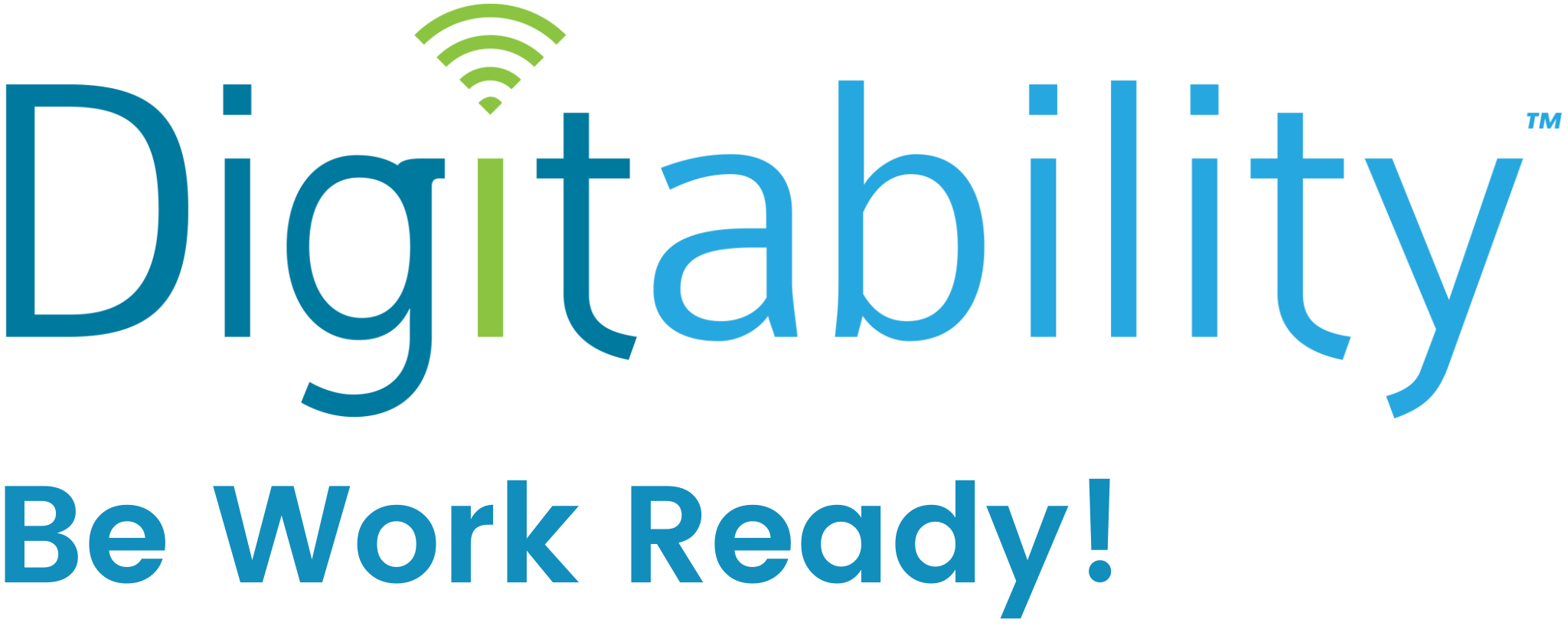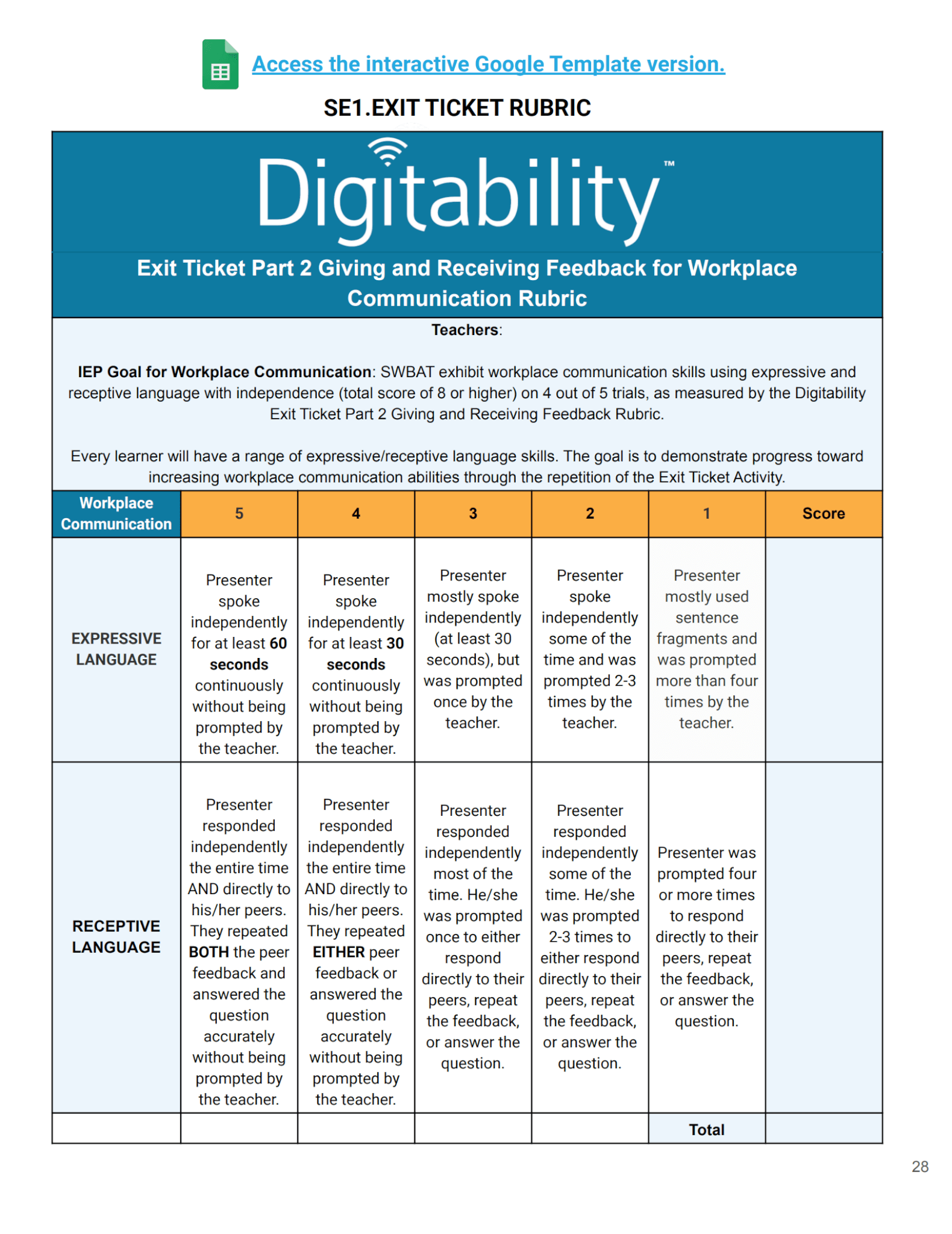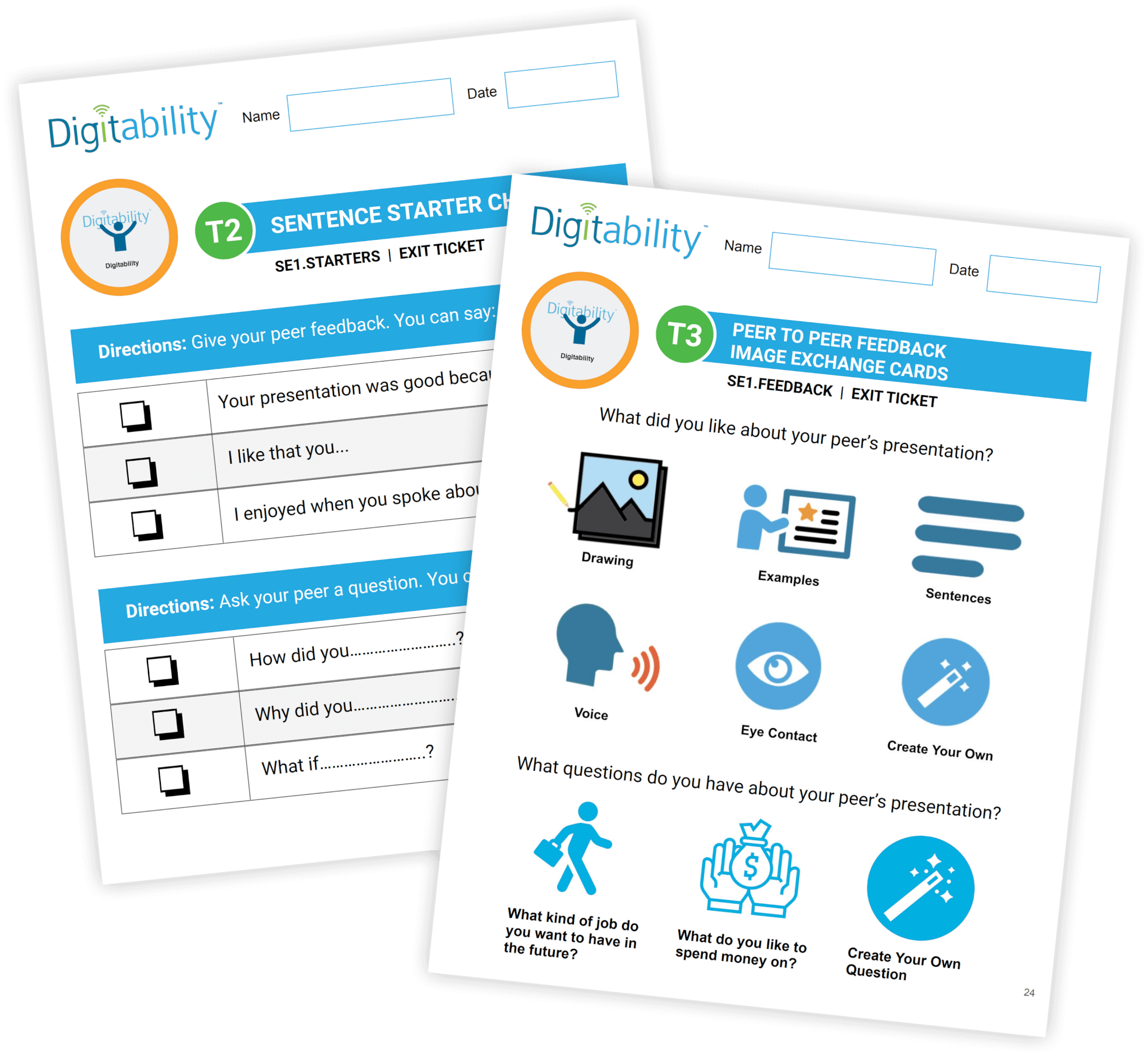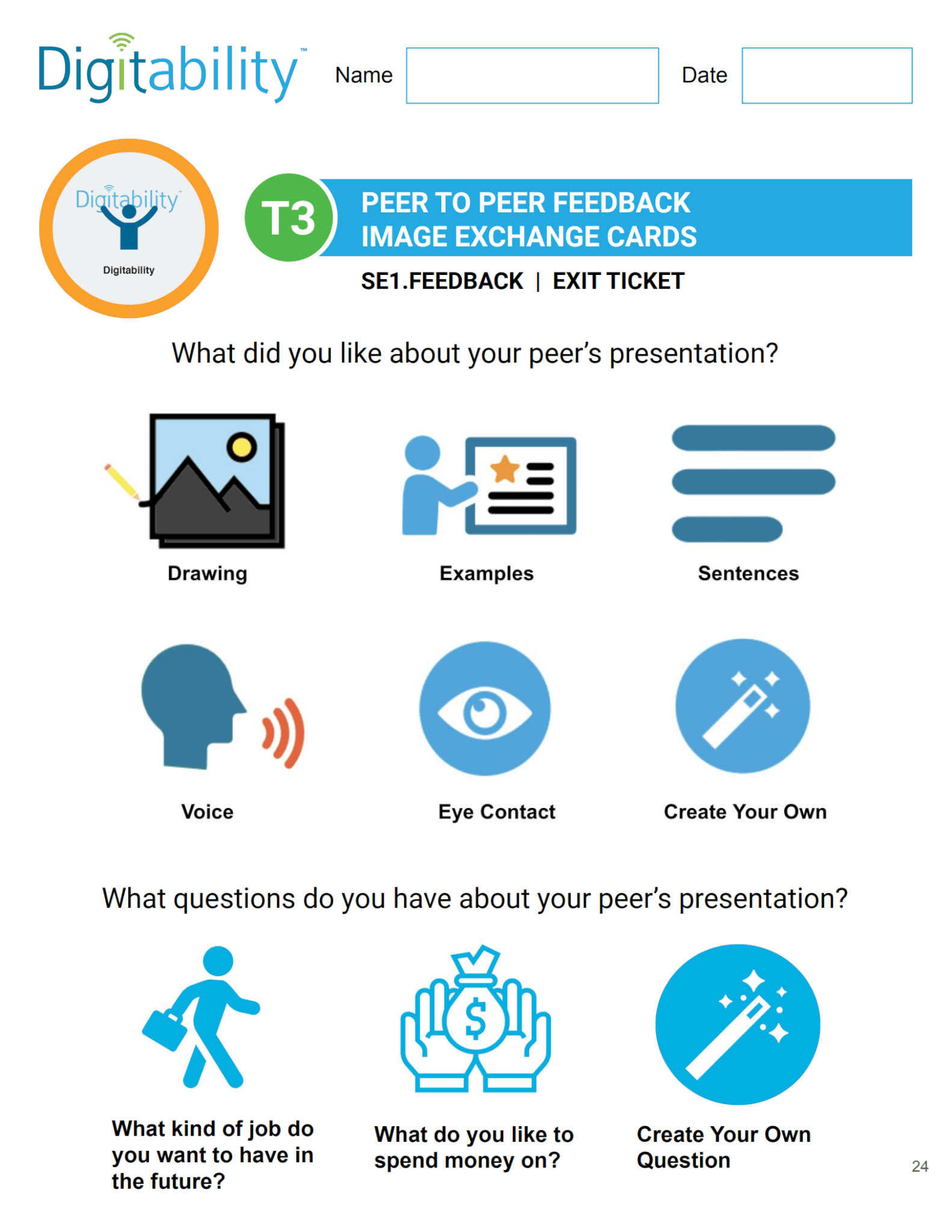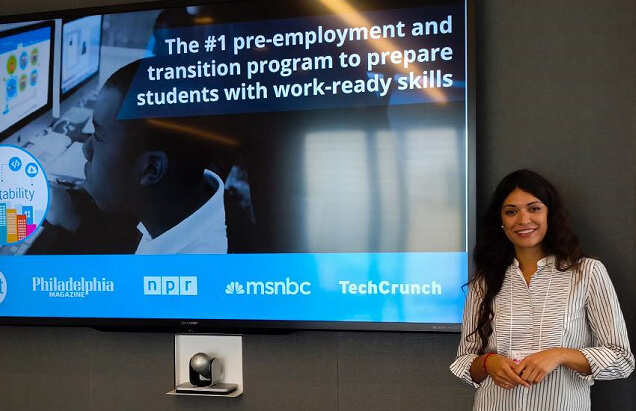Modifying Instruction During Exit Ticket Part 2
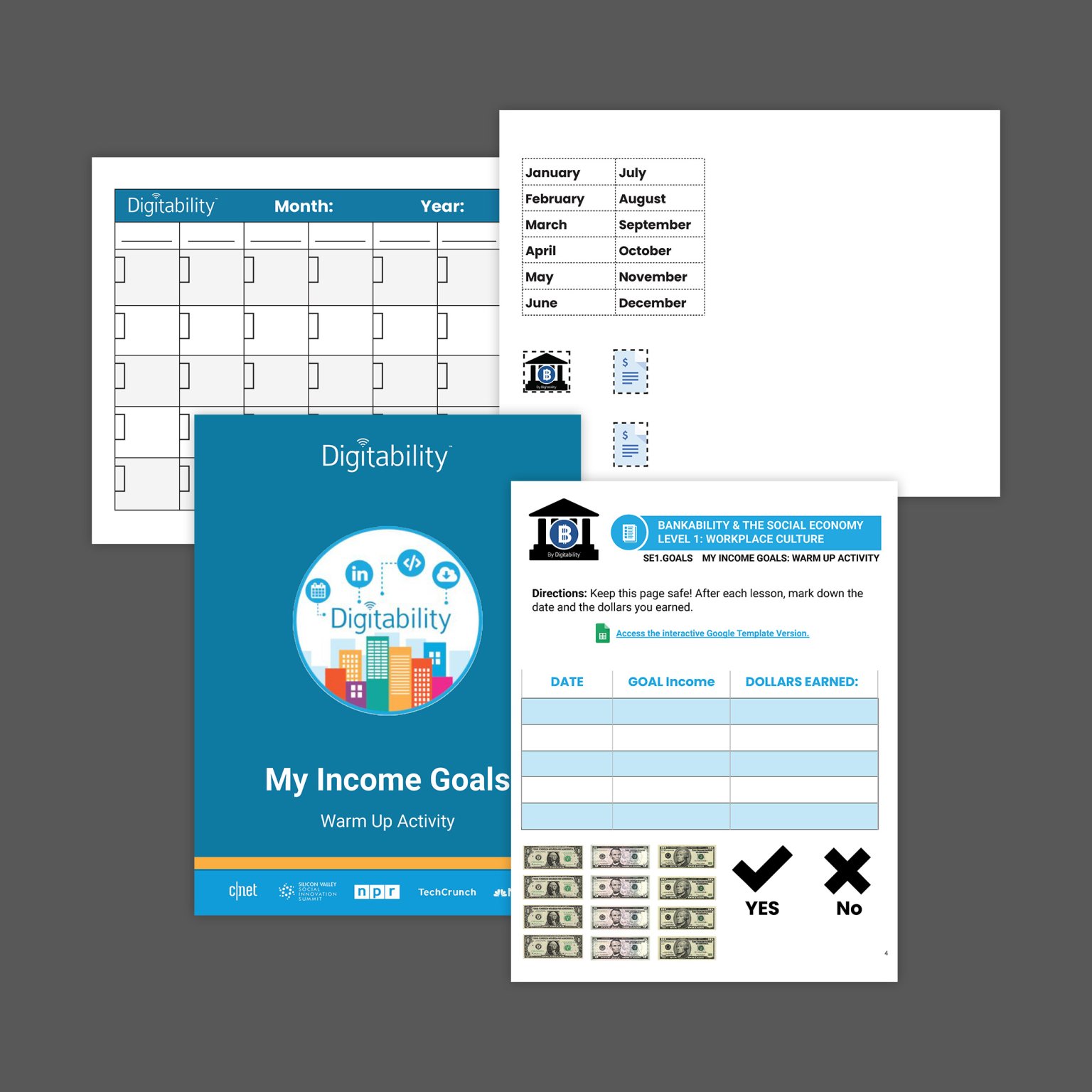
No Two Students are the Same; Neither are their IEP Goals
Each student requires something different when it comes to their list of IEP goals. Every day teachers are charged with finding ways to engage, support, motivate and differentiate for each of their students.
Digitability has organized strategies for streamline evidence-based practices for any given classroom with a wide-range of student needs including varying cognitive abilities, expressive and receptive language, self-regulation skills, and age-appropriate behavior. It’s a tall order for life skills teachers to manage.
Get Your FREE Quote Today!
Overview of the Exit Ticket Part 2
In Part 2 of the Exit Ticket, selected students will present their Exit Ticket and other students can give them feedback on it. The goal of this is to shift the classroom dynamic from being teacher-led to student-driven. There should be a focus on peer-to-peer conversation, and teachers should redirect students to their peers rather than facilitating conversations for them. If a student looks toward a teacher for direction, the teacher can direct the student back to their peers by saying “Abbey is presenting her Exit Ticket right now. If you have a question about it, ask Abbey!” Or to the student presenting the teacher could say “You are presenting, ask your classmates if they have any feedback or questions for you.”
Included in each lesson plan is the Giving and Receiving Feedback for Workplace Communication Rubric. This rubric is used to score Exit Ticket Part 2 in the areas of expressive and receptive communication. By using this rubric to score students’ Exit Tickets Part 2, and entering the scores into Bankability, data will automatically be tracked in these areas. A teacher can look at this data and make decisions based on student performance, such as increasing or decreasing the level of differentiation that is provided to a student.
Not every student will present and/or give feedback in every lesson, but every student will complete an Exit Ticket worksheet for every lesson. As time allows, the teacher will select a number of students to come up and present whichever leveled resource they used to complete their Exit Ticket.
The goal of this is to strengthen workplace communication. While students are presenting, teachers should provide as little prompting as possible for the student to be successful. An objective here is to allow peer to peer communication.
After a student has presented their Exit Ticket, the teacher will call on another student to provide feedback. When giving feedback, students should tell their peer both something they like about their presentation and one question they have.
To support students in facilitating their feedback, the Supplemental Materials section of the lesson has differentiated resources. One resource includes a variety of sentence starters for both what they like about the presentation and for a question they may have. These sentence starters can help get students thinking about how to phrase and communicate their feedback. Additionally, a visually supported resource is available for students to provide feedback. This resource has six options with both images and words for students to communicate what they like about the presentation. It also includes three possible questions that students could ask in both words and image format. These supports are designed so that every student in the class can participate in presenting and giving feedback.
Meet the Student Personas
Note: The following personas are meant to illustrate a range of cognitive, communicative and behavioral needs for a wide-range of learning styles. These personas were created to help teachers identify the characteristics and associated strategies for their students needs.

Advanced Tier 1 Student: Drew can read, write, and comprehend paragraphs. Academically, he is one year below grade level. He is reinforced by getting time to use his phone during school. Drew has low motivation to complete assignments. He has difficulty with self-regulation and responsible decision making. He also has difficulty with impulse control. Drew is charismatic and his peers are drawn to him, giving him the potential to be a leader.

Tier 1 Student: Marcus can speak in 2-3 sentences and is able to read and comprehend paragraphs. He is reinforced by watching videos on Youtube. Marcus’ behaviors that impede learning include interrupting and complaining. He consistently is helpful with other students in the class and is a strong problem solver.

Tier 2 Student: Abbey can speak in 4-5 word utterances, and she is able to read with little comprehension. Abbey is reinforced by listening to music. She has some behaviors that interfere with learning, such as making off topic comments and teasing others. Abbey tends to perseverate on fairies and princesses, which contributes to her off topic comments. However, Abbey is an active participant in lessons and frequently shares with her peers.

Tier 3 Student: Jonathan is primarily nonverbal, he uses a communication device inconsistently, and knows some signs. He is not yet reading and has limited listening comprehension. Jonathan is reinforced by playing computer games. He demonstrates behaviors that interfere with learning, such as aggressive behavior and not following directions. However, Jonathan consistently greets others and likes to participate in lessons.
Strategies for an Advanced Tier 1 Student

Advanced Tier 1 Student:
Functional Academics: Can read, write, and comprehend paragraphs; Academically, he is one year below grade level.
Language: Age-appropriate
Reinforcers: Time to use his phone during school
Behavior: Low motivation to complete assignments. Difficulty with self-regulation and difficulty with impulse control.
Strengths: Charismatic and his peers are drawn to him, giving him the potential to be a leader.
During the Exit Ticket Part 2:
When Drew presents his Exit Ticket, he can do so verbally by reading the paragraph that he wrote or typed. While presenting, Drew may engage in attention seeking behavior, such as using inappropriate language or speaking at a volume that is not appropriate for the classroom.
When Drew provides feedback to a peer, he should first be given the opportunity to respond verbally without additional support. If he does need additional motivation, the teacher can remind him that he is earning Participation Dollars that can go toward purchasing time on his cell phone.
Strategies for Addressing Attention Seeking Behavior
- When Drew engages in attention seeking behavior, the teacher should ignore the behavior and, as much as possible, instruct the rest of the class to pay no attention to the inappropriate behavior. Ignoring attention seeking behavior is important because it does not reinforce the behavior.
- Rather than addressing Drew individually and giving him the attention, the teacher can use Positive Narration to address the whole class and remind students about the reinforcement contingency. “When Marcus was presenting, he used appropriate language and voice volume, and he earned Participation Dollars. Let’s remember that in order to earn dollars, we need to be appropriate while presenting.”
- When Drew does appropriately present his Exit Ticket, the teacher can give him attention, which would be reinforcing.
- When Drew presents and gives feedback without engaging in inappropriate behavior, the teacher should provide immediate feedback using the embedded Digitability language formulas.
repeat the answer + describe the behavior + deliver consequence
"Drew presented his Exit Ticket to the class, great job earning a Participation Dollar!"
In Level 2 of Digitability's Workplace Behavior Unit, students will identify and practice both the behaviors that will support their success in the workplace, as well as those behaviors that can be perceived as problematic. In these lesson plans, Digitability will explicitly explain how complaining impacts the workplace and depict strategies for developing self-regulation skills and a self-advocacy plan. In this level of Digitability, the teacher can utilize the Social Economy to assign a $1 fee for complaining to help Drew analyze the frequency of this behavior and strengthen his strategies for self-regulation. To learn more, contact our team.

- What is an Extinction Burst? It is important to understand that with some interventions the behaviors may seem to increase in frequency, intensity or duration before they begin to decrease. This is called an extinction burst. Evidence-based practices embedded in Digitability's Social Economy are tools that should be used consistently in order to be effective. It won't be a one-and-done solution!
Strategies for a Tier 1 Student

Tier 1 Student:
Functional Academics: Can read and comprehend paragraphs
Language: Can speak in 2-3 sentences
Reinforcers: Watching videos on Youtube
Behavior: Interrupting and Complaining
Strengths: Consistently helpful with other students, strong problem solver
During the Exit Ticket Part 2: When Marcus presents his Exit Ticket, he can do so verbally by reading the paragraph that he wrote or typed.
When providing feedback, Marcus should first be given the opportunity to respond verbally without any additional support. If Marcus does require additional assistance, he can be provided with the list of sentence starters to help him provide feedback to his classmates.
Strategies for Extending Responses
- The teacher should prompt him to expand his feedback to be meaningful, and beyond something simple such as “I like your drawing.” He should be prompted to say something along the lines of “I like the detail you put in your drawing, I can see that you drew the internet connecting people around the world.”
- The teacher should be sure to prompt Marcus to include both something he liked about the Exit Ticket and a question he has for the presenter. Marcus can be given sentence starters to aid him in coming up with ideas.
- When Marcus provides feedback including all areas that are necessary, the teacher should provide immediate feedback using the embedded Digitability language formulas.
repeat the answer + describe the behavior + deliver consequence
"Marcus gave feedback to his classmate, great job earning a Participation Dollar!"
- In Level 2 of Digitability's Workplace Behavior Unit, students will identify and practice more behaviors in the workplace that will support their success in the workplace as well as those behaviors that can be perceived as problematic. In these lesson plans, Digitability will explicitly explain how complaining impacts the workplace and strategies for developing self-regulation skills and self-advocacy plans for the workplace. To learn more, contact our team.
Strategies for a Tier 2 Student

Tier 2 Student:
Functional Academics: Can read with little comprehension, some writing skills, low IQ
Language: Speaks in 4-5 word utterances
Reinforcers: Listening to music
Behavior: Making off-topic comments due to perseverating on fairies and princesses, teasing others
Strengths: Actively participates in lessons, frequently shares with peers
During the Exit Ticket Part 2: When Abbey presents her Exit Ticket, she can do so verbally either by talking about what she wrote or by repeating after a teacher who reads what she wrote.
When providing feedback to another student, Abbey can be provided with the list of sentence starters. While providing feedback to a peer, Abbey may engage in disrespectful behavior by making mean comments to the peer who has presented.
Strategies for Addressing Disrespect
- “Abbey, remember, being disrespectful will not earn dollars, and you need dollars to buy time to listen to music. Let's try again to give feedback nicely."
- The teacher could also use Positive Narration: “Marcus gave feedback while also being kind to his classmates. He earned a Participation Dollar! Who else would like to earn a Participation Dollar?"
- Once Abbey is ready to give feedback appropriately, the teacher will need to prompt Abbey through providing feedback.
- The teacher can prompt her by reading the sentence starters and allowing Abbey to complete the sentences. If Abbey requires additional assistance, she can be shown the Image Exchange Cards that support giving feedback. When she makes a selection, the teacher can model the full sentence and Abbey can repeat it. The teacher should be sure to prompt Abbey to include both something she liked about the Exit Ticket and a question for the presenter.
- When Abbey provides feedback to her peer, the teacher should provide immediate feedback using the embedded Digitability language formulas.
repeat the answer + describe the behavior + deliver consequence
"Abbey gave feedback to her peer, great job earning a Participation Dollar!"
- In Level 2 of Digitability's Workplace Behavior Unit, students will identify and practice more behaviors in the workplace that will support their success in the workplace as well as those behaviors that can be perceived as problematic. In these lesson plans, Digitability will explicitly explain how complaining impacts the workplace and strategies for developing self-regulation skills and self-advocacy plans for the workplace. To learn more, contact our team.
Strategies for a Tier 3 Student

Tier 3 Student:
Functional Academics: Not yet reading, limited listening comprehension, low IQ
Language: Primarily nonverbal, uses a communication device inconsistently, knows some signs
Reinforcers: Playing computer games
Behavior: Aggressive behavior, not following directions
Strengths: Consistently greets other, enjoys participating in lessons
During the Exit Ticket Part 2: When Jonathan presents his Exit Ticket, he can do so using his communication device with a teacher prompting him through it, or he can point and follow along with his finger while a teacher reads his definition aloud.
When providing feedback, Jonathan should be provided with the Image Exchange Cards in order to both share something he liked about his peer’s Exit Ticket and a question he had. The teacher should use prompting as necessary to have Jonathan point to or exchange at least one Image Exchange Card for each feedback response.
Strategies for Prompting a Tier 3 Student
- A visual prompt can be provided by giving Jonathan the Image Exchange Cards to give him options for providing feedback.
- A gestural prompt can be given by gesturing or pointing to the Image Exchange Card that may be most appropriate in the given situation.
- The teacher can give a positional prompt by positioning the desired feedback card closer to the student.

A partial physical prompt could include the teacher nudging Jonathan toward the Image Exchange Cards. A full physical prompt would include the teacher using a hand over hand method to help Jonathan select an Image Exchange Card.
- When Jonathan provides feedback, the teacher should provide immediate feedback using the embedded Digitability language formulas.
repeat the answer + describe the behavior + deliver consequence
"Jonathan gave feedback to his peer, great job earning a Participation Dollar!"
- In Level 2 of Digitability's Workplace Behavior Unit, students will identify and practice more behaviors in the workplace that will support their success in the workplace as well as those behaviors that can be perceived as problematic. In these lesson plans, Digitability will explicitly explain how complaining impacts the workplace and strategies for developing self-regulation skills and self-advocacy plans for the workplace. To learn more, contact our team.
If you need additional resources or assistance in differentiation, reach out to your coach!
